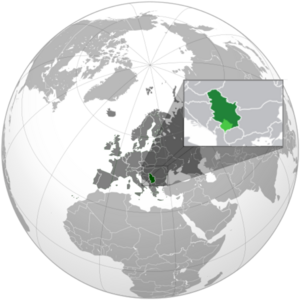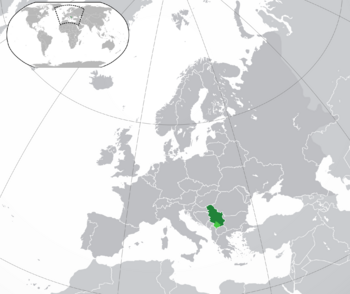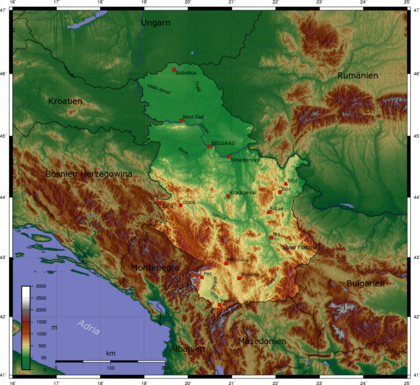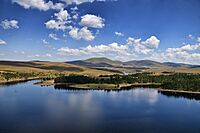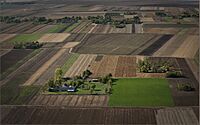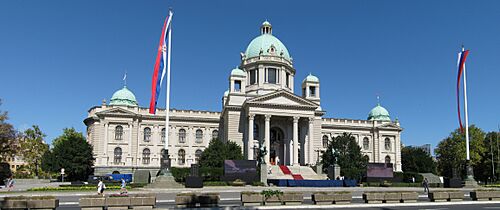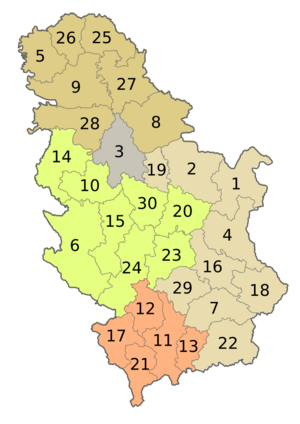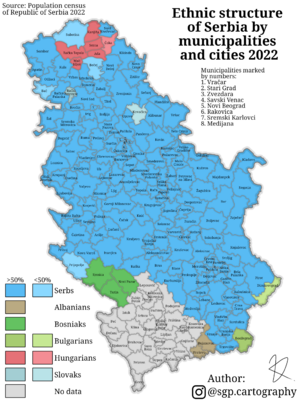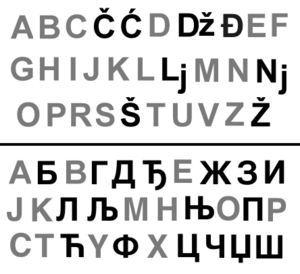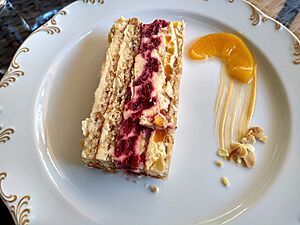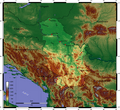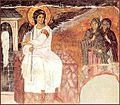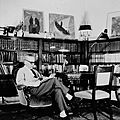Serbia facts for kids
Quick facts for kids
Republic of Serbia
Република Србија,
Republika Srbija (Serbian) |
|
|---|---|
|
Location of Serbia (green) and the claimed but uncontrolled territory of Kosovo (light green) in Europe (dark grey)
|
|
| Capital and largest city
|
Belgrade 44°48′N 20°28′E / 44.800°N 20.467°E |
| Official languages | Serbian |
| Ethnic groups
(2022; excluding Kosovo)
|
|
| Religion
(2022; excluding Kosovo)
|
|
| Demonym(s) | Serbian |
| Government | Unitary parliamentary republic |
| Aleksandar Vučić | |
| Vacant | |
|
• President of the National Assembly
|
Ana Brnabić |
| Legislature | National Assembly |
| Establishment history | |
|
• Principality
|
780 |
|
• Kingdom
|
1217 |
|
• Empire
|
1346 |
| 1459–1804 | |
|
• Serbian Revolution
|
1804–1835 |
| 1815 | |
| 13 July 1878 | |
| 18 March 1882 | |
| 1 December 1918 | |
| 27 April 1992 | |
|
• Independence restored
|
5 June 2006 |
| Area | |
|
• Total
|
88,499 km2 (34,170 sq mi) (111th) |
|
• Excluding Kosovo
|
77,612 km2 (29,966 sq mi) |
| Population | |
|
• January 2024 estimate
|
|
|
• 2022 census
|
|
|
• Density
|
85/km2 (220.1/sq mi) (130th) |
| GDP (PPP) | 2024 estimate |
|
• Total
|
|
|
• Per capita
|
|
| GDP (nominal) | 2024 estimate |
|
• Total
|
|
|
• Per capita
|
|
| Gini (2023) | ▼ 31.7 medium |
| HDI (2022) | very high · 65th |
| Currency | Serbian dinar (RSD) |
| Time zone | UTC+1 (CET) |
|
• Summer (DST)
|
UTC+2 (CEST) |
| Calling code | +381 |
| ISO 3166 code | RS |
| Internet TLD |
|
The Republic of Serbia (Serbian: Република Србија / Republika Srbija), or just Serbia (Serbian: Србија / Srbija), is a country in Central Europe. Its capital city is Belgrade.
Serbia shares borders with several countries. To the north is Hungary. To the east, you'll find Bulgaria and Romania. South of Serbia are North Macedonia and Kosovo. To the west are Montenegro, Bosnia and Herzegovina, and Croatia.
Contents
Serbia's Past: A Quick Look at History
People have lived in the area that is now Serbia since the Stone Age. Slavic groups moved here in the 6th century. Over time, different states formed.
The Serbian Kingdom was officially recognized in 1217. It grew into the powerful Serbian Empire by 1346. In the 1500s, the Ottomans took control of most of modern Serbia.
In the early 1800s, the Serbian Revolution led to the creation of a new Serbian state. This state grew and became the Kingdom of Serbia in 1882. After World War I, Serbia joined with other South Slavic nations to form Yugoslavia.
Yugoslavia existed in different forms until the 1990s. In 2006, Serbia became an independent country again. This was the first time since 1918 that Serbia was fully independent. In 2008, Kosovo declared its independence, but Serbia still considers it part of its own land.
Exploring Serbia's Geography
Serbia is a landlocked country, meaning it has no coastline. It's located where Central and Southeastern Europe meet. The country is part of the Balkan peninsula and the Pannonian Plain.
Serbia covers about 88,499 square kilometers. If you don't count Kosovo, it's about 77,474 square kilometers. Serbia shares borders with eight other countries.
The northern part of Serbia, called Vojvodina, is mostly flat. The central part has many hills and rivers. Mountains cover the southern third of Serbia. The Dinaric Alps are in the west and southwest. The Carpathian Mountains and Balkan Mountains are in eastern Serbia.
The highest peak in Serbia (not including Kosovo) is Midžor at 2,169 meters. The lowest point is near the Danube river at Prahovo, only 17 meters above sea level. The largest lake is Đerdap Lake, and the longest river flowing through Serbia is the Danube.
Serbia's Climate: Weather Patterns
Serbia's weather is affected by both Europe and the Atlantic Ocean. Winters are cold, with average January temperatures around 0°C (32°F). Summers are hot and humid, with average July temperatures around 22°C (72°F).
In the north, winters are colder and summers are hot and wet. In the south, summers and autumns are drier. Winters in the mountains can have heavy snowfall.
A special wind called Košava blows from the Carpathian Mountains. It's a cold, strong wind that follows the Danube river. It can reach Belgrade and even further south.
The lowest temperature ever recorded in Serbia was -39.5°C (-39.1°F) in 1985. The highest was 44.9°C (112.8°F) in 2007. Serbia faces risks from natural events like earthquakes, storms, and floods. In May 2014, major floods caused a lot of damage and sadly, 57 people lost their lives.
How Serbia is Governed: Politics
Serbia is a parliamentary republic. This means its government has three main parts:
- The legislative branch makes laws.
- The executive branch carries out the laws.
- The judiciary branch interprets the laws.
The country's rules are set by its Constitution, which was adopted in 2006. The Constitutional Court makes sure laws follow the Constitution.
The President is the head of state. People vote for the President every five years, and a president can serve a maximum of two terms. The President is also the leader of the armed forces. They help choose the Prime Minister and have some say in how Serbia deals with other countries.
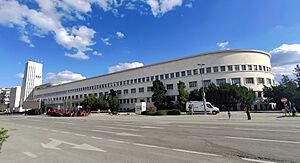
The Government (Vlada) is made up of the Prime Minister and other ministers. The Government suggests new laws, manages the country's money, and guides Serbia's policies.
The National Assembly (Narodna skupština) is Serbia's law-making body. It has 250 members who are elected for four-year terms. The National Assembly creates laws, approves the budget, and chooses the Prime Minister. It also decides on war and peace, and approves international agreements.
Serbia is doing well in having women in important government jobs. In 2021, Serbia was the 5th country in Europe for the number of women in high-ranking public positions.
How Serbia is Divided: Administrative Areas
Serbia is a unitary state. This means the central government has most of the power. The country is divided into municipalities, cities, districts, and two special areas called autonomous provinces.
Excluding Kosovo, Serbia has 145 municipalities and 29 cities. These are the main local government units. There are also 24 districts, plus the City of Belgrade, which is like its own district. Districts are regional centers for the government but don't have their own power.
Serbia's Constitution recognizes two autonomous provinces: Vojvodina in the north and Kosovo in the south. However, after the Kosovo War, UN peacekeepers entered Kosovo. Serbia does not recognize Kosovo's declaration of independence from 2008.
|
People of Serbia: Demographics
In 2022, Serbia (not including Kosovo) had a population of 6,647,003 people. This means there are about 85.8 people per square kilometer. Kosovo had its own census, counting 1,739,825 people.
During the 1990s, many refugees came to Serbia, making it home to the largest refugee population in Europe at that time.
Most people in Serbia are Serbs, making up about 81% of the population. Serbia has many different national minorities. The Vojvodina province is especially known for its many different ethnic groups and cultures.
The largest minority group is Hungarians, with about 184,442 people. They mostly live in northern Vojvodina. The Romani population is officially 131,936, but some guess their real number is much higher. Other groups include Bosniaks, Albanians, Croats, Slovaks, and Montenegrins. Chinese people are the largest non-European minority.
According to the World Happiness Report 2024, Serbia ranks 37th out of 140 countries for happiness.
Most people (59.4%) live in cities. Belgrade alone is home to about 16.1% of the population. Belgrade is the only city with over a million residents. Four other cities have more than 100,000 people.
|
Largest cities or towns in Serbia
|
||
|---|---|---|
| Rank | Name | Pop. |
| 1 | Belgrade | 1,197,714 |
| 2 | Novi Sad | 306,702 |
| 3 | Niš | 260,237 |
| 4 | Kragujevac | 146,315 |
| 5 | Subotica | 94,228 |
| 6 | Pančevo | 86,408 |
| 7 | Novi Pazar | 71,462 |
| 8 | Čačak | 69,598 |
| 9 | Kruševac | 68,119 |
| 10 | Zrenjanin | 67,129 |
Language in Serbia
The official language of Serbia is Serbian. About 88% of the population speaks it. Serbian is unique because it actively uses two alphabets: Cyrillic and Latin.
The Serbian Constitution states that Serbian Cyrillic is the "official script." However, people use both. A 2014 survey showed that 47% of Serbians prefer the Latin alphabet, 36% prefer Cyrillic, and 17% don't have a preference.
Serbia's Economy
Serbia has an upper-middle income economy. This means it's a developing country with a good standard of living.
Farmers in Serbia grow a lot of potatoes, tomatoes, and peppers. Serbia is also one of the world's biggest producers and exporters of raspberries. They are a top exporter of frozen fruit.
Serbia has five international airports. The main ones are Belgrade Nikola Tesla Airport and Niš Constantine the Great Airport.
Most homes in Serbia have landline phones. There are also over 9.6 million cell phone users, which is more than the total population!
Culture in Serbia
Serbia has a rich culture with many historical sites. Eight of its sites are on the UNESCO World Heritage list. These include old monasteries like Studenica and Sopoćani, and the ancient Roman palace of Gamzigrad–Felix Romuliana.
Two important historical documents are also on UNESCO's Memory of the World Programme. These are the 12th-century Miroslav Gospel and the valuable papers of scientist Nikola Tesla.
Serbian Cuisine: Delicious Food
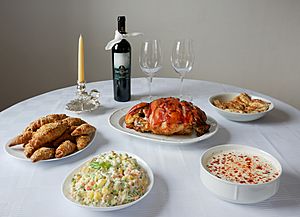
Serbian food is a mix of different influences, especially from the Balkans, Turkey, Austria, and Hungary. Food is very important in Serbian social life. This is especially true during holidays like Christmas, Easter, and family feast days called slava.
Bread, meat, fruits, vegetables, and dairy products are common in the Serbian diet. Bread is so important that it's used in religious traditions. A traditional Serbian welcome for guests is to offer them bread and salt.
Meat and fish are widely eaten. The city of Leskovac in southern Serbia hosts the Roštiljijada, a huge barbecue festival.
Some popular Serbian dishes include:
- ćevapčići: Grilled sausages without casings, made from minced meat.
- pljeskavica: A grilled spiced meat patty.
- gibanica: A tasty cheese pie.
- burek: A baked pastry with meat, cheese, or vegetables.
- sarma: Stuffed cabbage rolls.
- ajvar: A spread made from roasted red peppers.
- kajmak: A creamy dairy product, similar to clotted cream.
Serbians say their country is where rakia (rakija) was invented. This is a strong alcoholic drink made from fruit. Slivovitz (šljivovica), a plum brandy, is considered Serbia's national drink. In 2021, UNESCO recognized Slivovitz as an important tradition to be preserved.
Serbia also produces wine in 22 different regions. White wine is the most common. Besides rakia and wine, beer is very popular. The most famous local beers are Jelen and Lav.
Like in other former Yugoslav countries, drinking coffee is a big part of the culture. Serbian coffee, similar to Turkish coffee, is the most popular non-alcoholic drink.
Popular Sports in Serbia
The most popular sports in Serbia are football, basketball, volleyball, handball, water polo, and tennis.
The three biggest football clubs are Red Star and Partizan from Belgrade, and Vojvodina from Novi Sad.
Serbia is home to famous tennis players like Novak Djokovic, who has won many Grand Slam titles and is a top player. Other well-known Serbian tennis players include Ana Ivanovic and Jelena Jankovic.
Related pages
Images for kids
-
Remnants of the Felix Romuliana Imperial Palace, a UNESCO World Heritage Site. Many Roman emperors were born in modern-day Serbia.
-
The Serbian Empire, a medieval state that grew from the Kingdom of Serbia. It was founded in 1346 by Dušan the Mighty.
-
The Battle of Kosovo (1389) is very important to Serbian history and national identity.
-
Great Serbian Retreat in 1915 led by Peter I of Serbia. Serbia lost about 850,000 people in World War I.
-
The Great Assembly in Novi Sad in 1918. It proclaimed the unification of Vojvodina with the Kingdom of Serbia.
-
Mothers with children in the Stara Gradiška concentration camp during World War II.
-
The First Non-Aligned Movement Summit Conference took place in Belgrade in September 1961.
-
Topographic map of Serbia, including Kosovo.
-
Uvac Gorge, one of the last places where the griffon vulture lives in Europe.
-
NIS headquarters in Novi Sad.
-
The Fiat 500L car is made in the FCA plant in Kragujevac.
-
Air Serbia's airplane taking off from Belgrade Nikola Tesla Airport.
-
Performance artist Marina Abramović.
-
Miroslav's Gospel (1186) is an old, illustrated manuscript listed in UNESCO's Memory of the World Register.
-
Ivo Andrić, a Yugoslav writer and Nobel Prize winner in 1961, in his home in Belgrade.
-
Exit Festival in Novi Sad, named the Best Major European festival.
-
A Serbian Christmas meal with roast pork, Russian salad and red wine.
-
Gibanica, a Serbian pastry often made with cottage cheese and eggs.
-
Tennis player Novak Djokovic, who has won many Grand Slam men's singles titles.
-
Nikola Jokić, a two-time NBA MVP and four-time NBA All-Star. Serbia has many players in the NBA.
See also
 In Spanish: Serbia para niños
In Spanish: Serbia para niños




